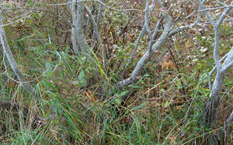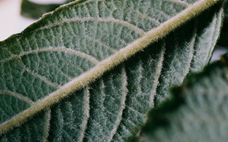(Salix atrocinerea (L.) Gaertn.) and Gray Willow (S.cinerea (L.) Gaertn.)
Family: Willow Family (Salicaceae)
Native Range: Europe, Western Siberia
European rusty willow is a tall shrub or small tree that grows up to 50 feet tall; it has smooth gray-green bark with a waxy texture and raised ridges in the wood. Gray willow is a multi-stemmed shrub that may grow up to 20 feet tall. The two willows are closely related and sometimes classified as a single species. They can also hybridize with several other willows, making identification difficult.
The branches of rusty willow are reddish to yellowish, and may have loose hairs; in autumn, the flower buds of rusty willow are smooth and red. The branches and buds of gray willow are grayish with a dense covering of fine gray hairs. Leaves of both the rusty and gray willow are roughly oval or egg-shaped with short pointed tips; the edges may be smooth or toothed. The upper surfaces of rusty willow leaves are bright green and shiny; the lower surfaces may be smooth or have reddish hairs; prominent veins on the undersides give the upper surface a ridged texture. The leaves of the gray willow are dull green; the undersides have gray hairs. Both willows hold their leaves through November or December and flower in early spring.
The upright catkins of both species are short-stalked and densely flowered; the flower stem is never exposed. These willows grow in wetlands and wet meadows, along rivers, ponds, and lakes, and in disturbed areas.
Rusty Willow
Gray Willow
Reproductive/Dispersal Methods
The fruits of both willows are catkins that split open to release many seeds with cottony hairs. The seeds are dispersed by the wind. Broken twigs can also root and grow into new plants.
Similar Species
Extremely similar to several native willows, especially Bebb’s willow (S. bebbiana) and pussy willow (S. discolor). Field characteristics that help to distinguish the invasive willows are the ridged bark pattern on mature stems, the hairy leaf undersides, and buds of two sizes—the flower buds are distinctly larger than the leaf buds.
Impacts
Both willows can invade natural wetland habitats, crowding out native willows and other indigenous plants, including a number of rare species. They can also hybridize with native species, leading to the reduction or elimination of native willows in habitats that rusty and gray willow have invaded.
Distribution
Rusty willow is native to Europe and western Siberia. Gray willow is native to southern Europe and the Mediterranean. Both species have naturalized in the eastern United States, particularly in coastal areas and wetlands.
Sources and Links:
Salicicola.com: Article on the Willows of New England
http://www.salicicola.com/articles/atrocinerea/
Salicicola.com: Comparison of Salix cinerea and S. atrocinerea
http://www.salicicola.com/notes/atrocinerea_cinerea/
New England Wildflower Society presentation- “Which Willow?”
Photos from A. Zinovjev and I. Kadis “Willows of New England” Salicicola.com (see the first link above).



